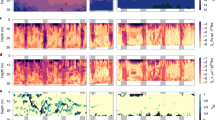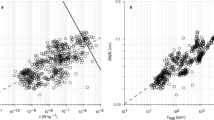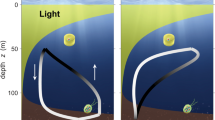Abstract
Biologically generated turbulence has been proposed as an important contributor to nutrient transport and ocean mixing1,2,3. However, to produce non-negligible transport and mixing, such turbulence must produce eddies at scales comparable to the length scales of stratification in the ocean. It has previously been argued that biologically generated turbulence is limited to the scale of the individual animals involved4, which would make turbulence created by highly abundant centimetre-scale zooplankton such as krill irrelevant to ocean mixing. Their small size notwithstanding, zooplankton form dense aggregations tens of metres in vertical extent as they undergo diurnal vertical migration over hundreds of metres3,5,6. This behaviour potentially introduces additional length scales—such as the scale of the aggregation—that are of relevance to animal interactions with the surrounding water column. Here we show that the collective vertical migration of centimetre-scale swimmers—as represented by the brine shrimp Artemia salina—generates aggregation-scale eddies that mix a stable density stratification, resulting in an effective turbulent diffusivity up to three orders of magnitude larger than the molecular diffusivity of salt. These observed large-scale mixing eddies are the result of flow in the wakes of the individual organisms coalescing to form a large-scale downward jet during upward swimming, even in the presence of a strong density stratification relative to typical values observed in the ocean. The results illustrate the potential for marine zooplankton to considerably alter the physical and biogeochemical structure of the water column, with potentially widespread effects owing to their high abundance in climatically important regions of the ocean7.
This is a preview of subscription content, access via your institution
Access options
Access Nature and 54 other Nature Portfolio journals
Get Nature+, our best-value online-access subscription
$29.99 / 30 days
cancel any time
Subscribe to this journal
Receive 51 print issues and online access
$199.00 per year
only $3.90 per issue
Buy this article
- Purchase on Springer Link
- Instant access to full article PDF
Prices may be subject to local taxes which are calculated during checkout




Similar content being viewed by others
References
Dewar, W. K. et al. Does the marine biosphere mix the ocean? J. Mar. Res. 64, 541–561 (2006).
Katija, K. & Dabiri, J. O. A viscosity-enhanced mechanism for biogenic ocean mixing. Nature 460, 624–626 (2009).
Huntley, M. E. & Zhou, M. Influence of animals on turbulence in the sea. Mar. Ecol. Prog. Ser. 273, 65–79 (2004).
Visser, A. W. Biomixing of the oceans? Science 316, 838–839 (2007).
Sato, M., Dower, J. F., Kunze, E. & Dewey, R. Second-order seasonal variability in diel vertical migration timing of euphausiids in a coastal inlet. Mar. Ecol. Prog. Ser. 480, 39–56 (2013).
Hamner, W. M., Hamner, P. P., Strand, S. W. & Gilmer, R. W. Behavior of antarctic krill, Euphausia superba: chemoreception, feeding, schooling, and molting. Science 220, 433–435 (1983).
Bianchi, D., Galbraith, E. D., Carozza, D. A., Mislan, K. A. S. & Stock, C. A. Intensification of open-ocean oxygen depletion by vertically migrating animals. Nat. Geosci. 6, 545–548 (2013).
Pedley, T. J. & Kessler, J. O. Hydrodynamic phenomena in suspensions of swimming microorganisms. Annu. Rev. Fluid Mech. 24, 313–358 (1992).
Koch, D. L. & Subramanian, G. Collective hydrodynamics of swimming microorganisms: living fluids. Annu. Rev. Fluid Mech. 43, 637–659 (2011).
Zhang, X. & Dam, H. G. Downward export of carbon by diel migrant mesozooplankton in the central equatorial Pacific. Deep Sea Res. Part II Top. Stud. Oceanogr. 44, 2191–2202 (1997).
Longhurst, A. R. & Glen Harrison, W. Vertical nitrogen flux from the oceanic photic zone by diel migrant zooplankton and nekton. Deep Sea Res. A 35, 881–889 (1988).
Wilhelmus, M. M. & Dabiri, J. O. Observations of large-scale fluid transport by laser-guided plankton aggregations. Phys. Fluids 26, 101302 (2014).
Hanamura, Y., Endo, Y. & Taniguchi, A. Underwater observations of the surface swarm of a euphausiid, Euphasia pacifica, in Sendai Bay, northeasterern Japan. Mer (Paris) 22, 63–68 (1984).
Kunze, E., Dower, J. F., Beveridge, I., Dewey, R. & Bartlett, K. P. Observations of biologically generated turbulence in a coastal inlet. Science 313, 1768–1770 (2006).
Omori, M. & Hamner, W. M. Patchy distribution of zooplankton: behavior, population assessment and sampling problems. Mar. Biol. 72, 193–200 (1982).
Catton, K. B., Webster, D. R., Kawaguchi, S. & Yen, J. The hydrodynamic disturbances of two species of krill: implications for aggregation structure. J. Exp. Biol. 214, 1845–1856 (2011).
Tarling, G. A. & Thorpe, S. E. Oceanic swarms of antarctic krill perform satiation sinking. Proc. R. Soc. B 284, 20172015 (2017).
Jackson, P. R. & Rehmann, C. R. Experiments on differential scalar mixing in turbulence in a sheared, stratified flow. J. Phys. Oceanogr. 44, 2661–2680 (2014).
Turner, J. S. Jets and plumes with negative or reversing buoyancy. J. Fluid Mech. 26, 779–792 (2006).
Shih, L. H., Koseff, J. R., Ivey, G. N. & Ferziger, J. H. Parameterization of turbulent fluxes and scales using homogeneous sheared stably stratified turbulence simulations. J. Fluid Mech. 525, 193–214 (2005).
Nash, J. D. & Moum, J. N. Microstructure estimates of turbulent salinity flux and the dissipation spectrum of salinity. J. Phys. Oceanogr. 32, 2312–2333 (2002).
Aref, H. & Jones, S. W. Enhanced separation of diffusing particles by chaotic advection. Phys. Fluids A 1, 470–474 (1989).
Moore, C. M. et al. Processes and patterns of oceanic nutrient limitation. Nat. Geosci. 6, 701–710 (2013).
DeLong, E. F. Microbial community genomics in the ocean. Nat. Rev. Microbiol. 3, 459–469 (2005).
Fuhrman, J. A., Cram, J. A. & Needham, D. M. Marine microbial community dynamics and their ecological interpretation. Nat. Rev. Microbiol. 13, 133–146 (2015).
Linden, P. F. Mixing across a density interface produced by grid turbulence. J. Fluid Mech. 100, 691–703 (2006).
Whitehead, J. A. & Stevenson, I. Turbulent mixing of two-layer stratified fluid. Phys. Fluids 19, 125104 (2007).
Economidou, M. & Hunt, G. R. Density stratified environments: the double-tank method. Exp. Fluids 46, 453–466 (2009).
Settles, G. S. Schlieren and Shadowgraph Techniques (Springer, Berlin, 2001).
Acknowledgements
We gratefully acknowledge M. M. Wilhelmus for the original development of laboratory controlled migrations and for advice on development of the current facility; E. Meiburg for technical advice; and R. Strickler for assistance in development of the schlieren imaging system and use of his facilities for obtaining Fig. 4a. We also gratefully acknowledge funding from the US National Science Foundation (Grant 1510607).
Author information
Authors and Affiliations
Contributions
I.A.H., J.O.D., J.R.K. and S.G.M. conceived the irreversible mixing experiments; I.A.H. and J.O.D. conceived the flow visualization experiments; I.A.H. conducted all experiments; all authors contributed to data analysis; I.A.H. and J.O.D. wrote the initial draft of the manuscript, and all authors contributed to manuscript revisions.
Corresponding author
Ethics declarations
Competing interests
The authors declare no competing interests.
Additional information
Publisher’s note: Springer Nature remains neutral with regard to jurisdictional claims in published maps and institutional affiliations.
Supplementary information
41586_2018_44_MOESM1_ESM.mp4
Video 1: Vertical migration video A 10x playback speed video of vertical migration in the 2-meter-tall tank, started approximately 2 minutes after activation of the blue laser
41586_2018_44_MOESM3_ESM.mp4
Video 2: Schlieren imaging video: single animal The schlieren imaging technique is used to visualize density gradients around a freely swimming animal in the 10 cm x 5 cm x 15 cm tank. The field of view is approximately 1.5 cm across and video playback is real time. The single swimmer produces a notable rearward jet, despite the very high buoyancy frequency of N ≈1.3 s−1 which causes the displaced fluid to quickly re-stratify
41586_2018_44_MOESM4_ESM.mp4
Video 3: Schlieren imaging video: migration The schlieren imaging technique is used to visualize density perturbations near a vertical migration. The field of view is approximately 5 cm across and video playback is at 10x speed. The field of view is centered approximately 8 cm to the left of the center of the migration, where the animal migration appears less coordinated
41586_2018_44_MOESM5_ESM.mp4
Video 4: Tracer particles within swarm video A red laser sheet was used to illuminate 10 micrometer neutrally buoyant particles in a plane through the center of the migration. The field of view is approximately 5 cm vertically. Video playback is at 4x speed
41586_2018_44_MOESM6_ESM.mp4
Video 5: Large-scale tracer particle overlay video A set of 250 consecutive images, corresponding to 4.2 seconds of video, was used to create each new frame and shifted 30 images forward in time for each subsequent frame. This resulted in a video progressing at 7.5x speed, illustrating the large-scale eddies propagating laterally outward from the central migration. The field of view is 40 cm vertically and 22 cm horizontally
41586_2018_44_MOESM7_ESM.mp4
Video 6: Planar laser induced fluorescence video A 10x playback speed video of planar laser induced fluorescence obtained in the 1.2-meter-tall tank with an interface buoyancy frequency of N int = 0.05 s−1. Video was obtained after a 120-minute mixing experiment, so the tank was stably stratified over the entire vertical extent of the tank (i.e. profile in Fig. 2b ’final’)
Rights and permissions
About this article
Cite this article
Houghton, I.A., Koseff, J.R., Monismith, S.G. et al. Vertically migrating swimmers generate aggregation-scale eddies in a stratified column. Nature 556, 497–500 (2018). https://doi.org/10.1038/s41586-018-0044-z
Received:
Accepted:
Published:
Issue Date:
DOI: https://doi.org/10.1038/s41586-018-0044-z
This article is cited by
-
Intense upper ocean mixing due to large aggregations of spawning fish
Nature Geoscience (2022)
-
A review on gyrotactic swimmers in turbulent flows
Acta Mechanica Sinica (2022)
-
A single-camera, 3D scanning velocimetry system for quantifying active particle aggregations
Experiments in Fluids (2021)
-
The importance of Antarctic krill in biogeochemical cycles
Nature Communications (2019)
-
On biogenic turbulence production and mixing from vertically migrating zooplankton in lakes
Aquatic Sciences (2018)
Comments
By submitting a comment you agree to abide by our Terms and Community Guidelines. If you find something abusive or that does not comply with our terms or guidelines please flag it as inappropriate.



